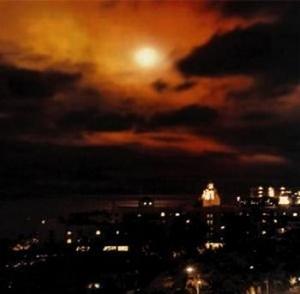EMP Pearl Harbor?U.K. defense minister lends support to notion of an EMP threat
The U.K. minister of defense, Liam Fox, appears to be lending support to the idea of an imminent electromagnetic strike against the West; in speech to an EMP-threat organization on Monday, Fox said that “As the nature of our technology becomes more complex, so the threat becomes more widespread — While we all benefit from the products of scientific advances so we also create vulnerabilities that can be exploited by our enemies. However advanced we become the chain of our security is only as strong as its weakest link”; security experts say an EMP strike is difficult to execute, and that a terrorist organization or a rogue state with only one bomb would rather use it to destroy a major city than disrupt the electrical grid and communication networks

EMP effect on Honolulu after 1962 high-altitude nuclear test // Source: blogspot.com
The U.K. defense minister Liam Fox appears to have bought into the notion that an electromagnetic pulse, or EMP, could be generated by terrorists or rouge state to disable the U.K. infrastructure.
The Telegraph reports on a behind-closed-doors speech by Dr. Fox at an event Monday organized by Avi Schnurr, an advocate of developing expensive defense technologies to ward off hostile EMP strikes. Schnurr is active in both the Israel Missile Defense Association and the Electric Infrastructure Security Council (EIS), which hosted Dr. Fox Monday.
“As the nature of our technology becomes more complex, so the threat becomes more widespread,” the defense secretary’s speech reads, according to the Telegraph.
“While we all benefit from the products of scientific advances so we also create vulnerabilities that can be exploited by our enemies. However advanced we become the chain of our security is only as strong as its weakest link.”
Lewis Page writes that the idea that terrorists or a rogue nation might launch a devastating electromagnetic pulse (EMP) strike against Western societies is an old one. It has tended to lack credibility as the only known way to generate a worthwhile EMP is to detonate a nuclear weapon, and most observers find it difficult to see why someone with nuclear bombs and the desire to hurt Western socieities would not simply blow up selected cities (see “How serious is the threat of an ‘EMP Pearl Harbor’?” 9 August 2010 HSNW; and “EMP threat to U.S. should be kept in perspective,” 10 September 2010 HSNW).
Page notes that there are fringe analysts who consider that an EMP can be generated easily using conventional explosives and equipment fabricated in a back-alley bomb making shop, but, in fact, even the U.S. military has never succeeded in building a useful conventional EMP weapon, either explosives-pumped or of the electrically-powered High Power Microwave (HPM) type.
Still, some argue — persistently argue — that somebody with only one bomb might prefer to let it off in low orbit above the target nation/region, so causing widespread line-of-sight disruption to power grids and electronics beneath. Security experts view this scenario with skepticism, noting that it is unlikely that adversaries with access to suborbital rockets and one nuclear bomb would use it to disrupt the electronic infrastructure of a country rather than destroy one of this country’s major cities — especially since detonating a nuclear bomb above that country’s territory would likely invite a devastating retaliation.
Page notes that one of Schnurr’s earliest converts in the United Kingdom was the Right Honorable James Arbuthnot, Tory chairman of the Parliamentary Defense Committee. Arbuthnot is nowadays a board member of Schnurr’s EIS organization, and was chairing Monday’s EIS Summit.
Dr. Fox now appears willing to encourage interest in the notion of an EMP threat by giving a speech in an event dedicated to elucidating that threat.
Page writes that this may have been made somewhat easier by the fact that lately the threat of damaging electromagnetic radiation from solar storms has gained credence, helped by reports from NASA and the U.S. National Academy of Sciences. There would be some overlap between the measures required to proof infrastructure against solar storms and that required against the possible EMP threat.
NASA warned last year of a possible, devastating “space Katrina” radiation storm, saying that the last such event back in the nineteenth century crippled the nascent telecoms industry — and stating that another storm of such strength is bound to occur sooner or later.
The radiation-storm and EMP threats are considered from the Ministry of Defense viewpoint to fall under “cyber” activities, one of the few MoD areas forecast to get a budget increase rather than savage cuts in the ongoing U..K Strategic Defense and Security Review (“U.K to increase spending on cybersecurity,” 16 September 2010 HSNW
